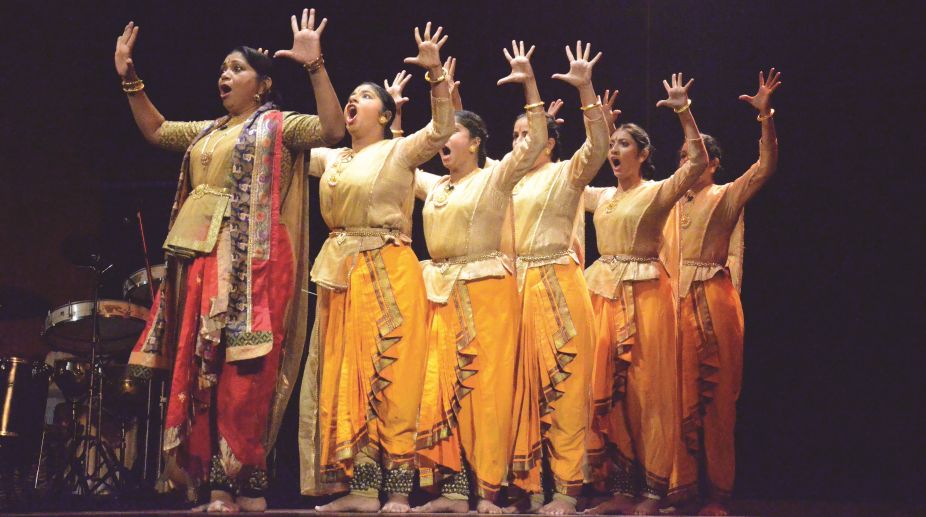Who was Saroja Vaidyanathan? Bharatanatyam dancer dies at 86
Renowned Bharatanatyam dancer Saroja Vaidyanathan passed away at her home early on Thursday, after bravely battling cancer. She had celebrated…
Featuring the country’s endless diversity, Creative Arts Fest, Sant-Vani and Aarambh mesmerised the Capital’s dance connoisseurs the past week. A review by Manjari Sinha.

Ravan Mandadori
Culture has been a diuturnal link to keep us united, despite the endless diversity of our country. Keeping this in mind Impresario India conceived Creative Arts Festival for inter-regional cultural exchange, showcasing works of Gurus and artistes from far away regions on one platform, way back in 1999, when there was no such opportunity.
The 20th edition of Impresario’s Creative Arts Festival showcased two dance works each evening at the Stein Auditorium. Guru Aniruddha Das and Nibedita Mohapatra from Odisha, opened the two-day festival with Draupadi in Odissi style, exploring the status of women in modern India, against the backdrop of Panchali, the princess Draupadi.
This was followed by Anekanta by Guru Geeta Chandran and her disciples in Bharatanatyam style, celebrating the diversity of multiple truth and the universal acceptance.
Advertisement
The concluding evening opened with the power-packed Ravan-Mandodari Samvad: Mandodari Ka Satya, a delightful dance production of Guru Rajashree Shirke from Mumbai in the Kathakar style of Kathak.
Guru Rajashri and her dynamic disciples changed roles in split seconds, becoming Ravan, Mandodari, Ram, Laxman, Sita, the Vanar Sena that built the bridge on sea or the Kathakar, who were telling the story.
The imaginative use of the Uttariya (Dupatta) and the moving abhinaya of Rajashree, living the agony of Mandodari or as the Birahi Ram looking for Sita like a mortal, asking the birds, animals and the bees, if they had seen his beloved Sita anywhere ~ “He khagamriga he madhukar shreni/tum dekhi Sita mrignayani…” composed in the pathos filled Kirwani ~ was superb.
Abhimanyu Vadh and the Panch-Bhoot Tillana presented by Guru Vanashree Rao and her gifted group, comprising dynamic dancers in Chhau, Bharatanatyam and Kuchipudi styles, were as impressive as ever.
Already reviewed in this column, she once again took the evening and the festival to its climax.
* * *
Sant Vani
The cultural space of Sangeet Shyamala, where legends have performed, feels rejuvenated after Chetna Jalan has taken over. Inspired by the success of the Spring Festival, Sangeet Shyamala presented this time Sant-Vani with Usha R K, who conceived it on the philosophy of women saint poets of India from the Bhakti-Yug.
Santvani focussed on two devotees ~ Andal from the South, who is the only female Alvar among the 12 saints of South India, and Meera from the North ~ who fell in love with the lord and chose Him as their husband, abandoning various social norms to follow their spiritual path.
The poetry of Andal, was interpreted in Bharatanatyam style by Shreyasi Gopinath, disciple of Guru Jamuna Krishnan, who selected Andal’s verses, composed music and choreographed for her.
The atmosphere was redolent with the strains of raga Varali when Shreyasi opened with Pushpanjali and followed it up with a song expressing Andal’s deep love for Vishnu.
Andal in this song describes to her friend how, surrounded by hundred elephants her Lord came to her, held her hand and accepted her.
In the second song Andal wonders where He has disappeared suddenly and asks the Conch shell, and the sea, if they have seen Him.
Unable to bear the pain of separation she sends Cuckoo as a messenger to sing His praise and bring Him back.
Andal’s ecstatic love and passion consumes her very being and she attains salvation and bliss when she sees the vision of Mahavishnu in front of her eyes.
Shreyasi deserves kudos also for her Abhinaya, interpreting Andal songs while enlivening her passion, devotion and yearning for her beloved Vishnu, which touched the hearts of the audience.
The Prem-Bhakti (divine love) of Meera, poured out in her poetry while she remained in ecstatic trance. It was interpreted in Kathak by Shipra Joshi, a talented disciple of Guru Prerana Shrimali. Shipra chose chose two poems of Meera, describing her intense love and devotion towards Krishna.
In the first song “Mori galiyan mein aaoji Ghanashyam…”, preceded with a Doha in Mand, as a prelude, Meera rightfully guides Krishna to come and meet her.
The song, set to Chanchar Theka of Deepchandi, gave way to the Teentala Lehra for the Nritta aspect of Kathak interspersed in between the song to underline the exuberance of joy and ecstasy.
The second song in Kirwani “Mhara janam maran re Saathi…” underlined the complete surrender of Meera and her realisation that the ultimate truth is only Krishna.
* * *
Aarambh
The Aarambh series by the Raza Foundation encouraging young performers with potential talents; presented Hindustani Vocal by Devashree Navaghare and Manipuri dance by Kankana Singh at the Triveni auditorium.
Initiated into Manipuri by her parents, Kankana was further groomed at Manipuri Nartanalaya under Guru Kalawati Devi and Guru Bimbavati Devi in the Shishya Parampara of Guru Bipin Singh.
The graceful dancer opened her performance with Radha Roop Varnan on the lyrics of Gobind Das, describing the beauty of Radha, the Brish Bhanu Kishori.
Changing into the attractive attire of Krishna, Kankana later presented the Makhan Chori and Kaliya-Daman Leelas of Krishna on Sapta Tala of 20 beats cycle, created by Guru Bipin Singh, before concluding her enchanting recital.
Advertisement